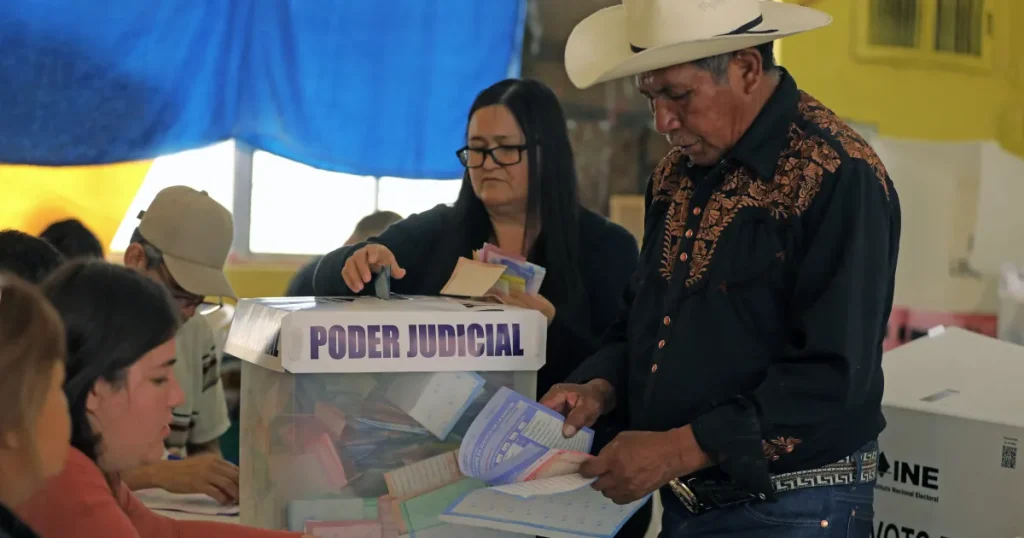On Sunday, 01st June 2025, Mexicans headed to the polls to elect every federal judge in the nation and many local ones — 2,682 justices, judges and magistrates in all — a first-in-the-nation vote to overhaul the judiciary.
The Mexican judicial elections, implemented in June 2025, represent a radical experiment in judicial reform by transitioning from an appointment-based system to a fully elected judiciary.
Morena’s[1] leaders said they decided on the election to fix a justice system rife with corrupt judges who served the elite, rather than everyone, and who kept frustrating the party’s plans. In the process, they could eliminate the final major check on Morena’s power.
Many legal and political analysts in Mexico expect candidates aligned with Morena to dominate the election, filling judgeships from local courthouses to the Supreme Court and giving the party effective control over the third branch of government.
This unprecedented model aims to address systemic issues but introduces significant risks. Below is a structured analysis of its advantages and disadvantages:
Advantages.
1. Enhanced Democratic Accountability.
– Public Oversight:
Proponents argue that electing judges makes the judiciary responsive to citizens’ needs, reducing corruption and elitism. President Claudia Sheinbaum frames this as empowering the people to “decide” justice priorities.
– Breaking Elite Capture:
The old appointment system allegedly favored political and economic elites. Elections could diversify the judiciary, as seen in candidates like Delia Quiroa, a human rights advocate running to represent marginalized communities .
2. **Addressing Systemic Corruption**
– **Combating Impunity**:
Mexico’s judiciary has long been perceived as corrupt, with only 8% of crimes reported due to low public trust. Elections aim to purge corrupt judges and align rulings with societal demands for justice.
– Reducing Nepotism:
Half of federal judges had family ties within the court system under the old model. Elections could disrupt such networks .
Disadvantages:
1. Threats to Judicial Independence.
– Political Influence:
Critics warn that elections enable ruling-party dominance (e.g., MORENA’s influence over candidate selection) and weaken checks on executive power. The new Judicial Discipline Tribunal—empowered to sanction judges without appeal—is largely staffed by ruling-party allies.
– Populist Pressures:
Judges may prioritize popular decisions over legal integrity to secure votes, eroding impartiality.
2. Organized Crime Infiltration.
– Criminal Ties:
Candidates with links to cartels, such as Silvia Delgado (ex-lawyer for “El Chapo” Guzmán) and Leopoldo Chávez (convicted drug smuggler), highlight lax vetting. The UN warns elections could increase vulnerability to criminal coercion.
– Violence Risks:
Judges are frequent targets of cartel violence; elected officials may face heightened intimidation.
3. Operational and Structural Flaws.
– Inadequate Vetting:
Basic qualifications (e.g., law degree + 5 years’ experience) fail to screen for competence or integrity. Watchdogs identified 20+ “high-risk” candidates, revealing systemic vetting failures.
– Voter Confusion & Low Turnout:
Complex ballots and unknown candidates led to projected turnout of 8–15%. Many voters boycotted, questioning legitimacy.
– Underfunding & Inequity:
Reduced polling stations and self-funded campaigns favor wealthy candidates, limiting accessibility.
Unresolved Tensions.
– Symbolic Reform vs. Systemic Fixes:
While elections target corruption, they ignore root causes like underfunded investigations and prosecutorial weaknesses.
– Global Precedent:
As the world’s first all-elected judiciary, Mexico’s experiment could inspire similar reforms elsewhere—or serve as a cautionary tale.
Key Outcomes Table.
| No. | Area | Potential Benefit | Key Risk |
| 1.0 | Accountabilit. | Judges responsive to public needs. | Ruling-party dominance weakening oversight. |
| 2.0 | Corruption. | Disruption of elite networks. | Organized crime infiltration. |
| 3.0 | Accessibility. | Diversified candidate pool. | Wealthy candidates advantaged by self-funding. |
Key Takeaways.
The Mexican model offers a democratic vision for judicial reform but risks trading one form of corruption for another—potentially exacerbating judicial politicization and criminal influence. Success hinges on addressing vetting flaws, ensuring judicial protection, and depoliticizing oversight.
As the International Crisis Group notes, this “grand experiment” could either remedy Mexico’s justice system or deepen its crises.
Can Tanzania emulate Mexican Style Judicial Reforms?
Ultimately, Tanzania will pursue Mexican Style Judicial Reforms in order to root out systemic and institutional failures experienced right now but the current election law regime will render the exercise futile.
The ruling party, CCM, will still pack the judiciary with allies defeating the objectives. While the aim would be to address nepotism, bribery, accountability and fair decision making but the final outcome will keep the “status quo” intact.
Therefore, while there are merits in Mexican Style Judicial Reforms, executive leaning election laws stand on the way to revamp the judiciary in a manner that it will conform with societal expectations.
Therefore, the golden key to meaningful judicial reforms in Tanzania is refurbishment of the executive lopsided to encompass latest technologies that will deliver transparent, free, fair and verifiable elections.
Until then such judicial reforms are not worthy the effort.
Read more analysis by Rutashubanyuma Nestory

